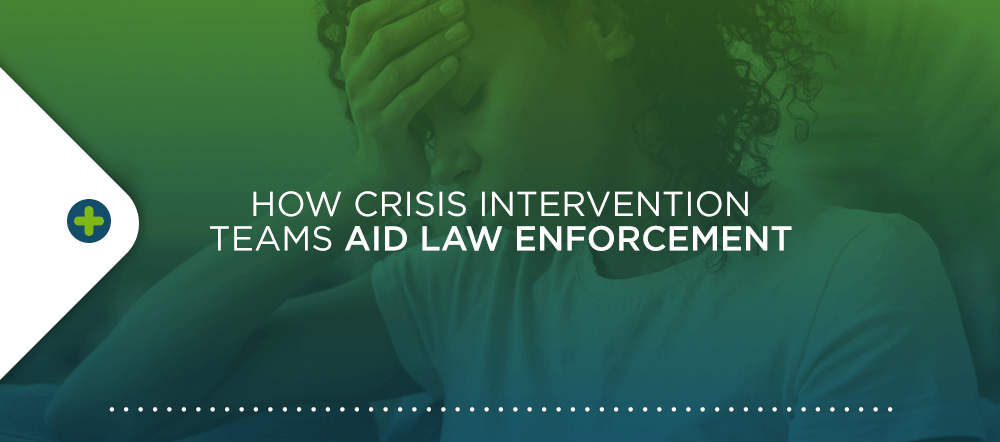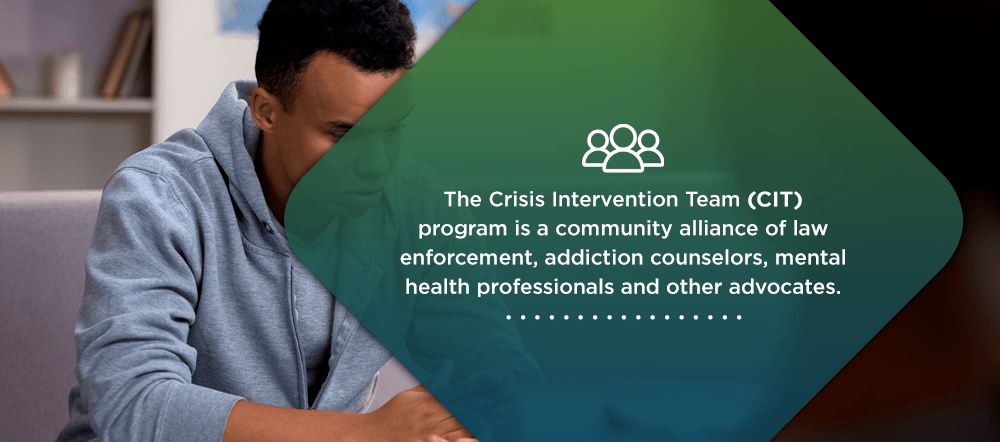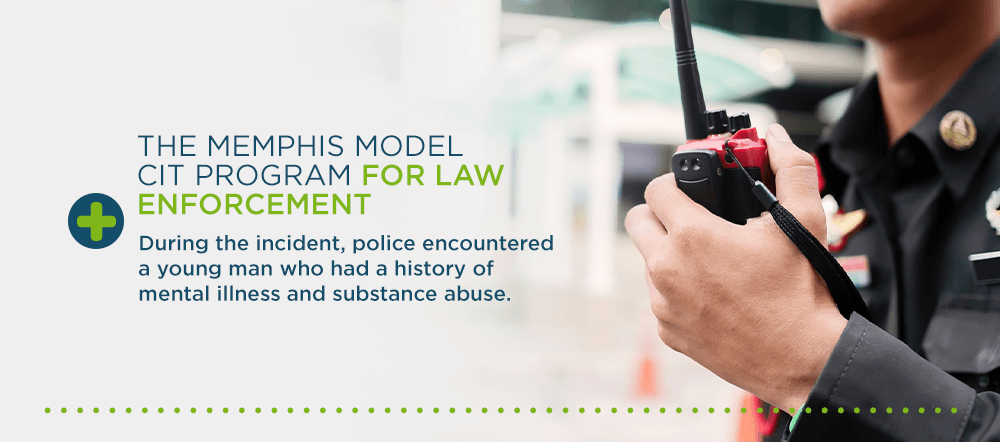
How a Mental Health Crisis Intervention Team Aids Law Enforcement
A mental health crisis can affect any person or any family. The American Psychological Association defines a crisis as a situation, such as a traumatic change, that "produces cognitive or emotional stress" in those involved. The Washington State Department of Social and Health Services describes a crisis as a breakdown or disturbance in a person's or family's usual pattern of functioning. Unlike a problem, which a person or family member can solve despite its difficulty, a mental health crisis cannot be resolved by an individual's usual problem-solving skills.
Different types of situations can cause a crisis, depending on a person's response to a stressful situation. For example, a significant life event such as losing a loved one or a natural disaster can lead to a state of crisis, characterized by anxiety, helplessness, fear, confusion or agitation. An emotional crisis may include self-injury, suicidal thoughts or substance abuse.
When a mental health crisis occurs, the individual or family involved needs assistance from a mental health professional or CIT trained first responder to manage the situation and prevent serious consequences. This is called a crisis intervention.
If you're a mental health professional or police officer who's curious about crisis intervention programs, this article is for you. We explore the principles of the mental health Crisis Intervention Team (CIT) program and how it helps law enforcement and the community at large.
What's the Meaning of Crisis Intervention?
Put simply, crisis intervention is emergency care for mental health. Social workers, counselors, psychologists and other mental health professionals are trained to help people in crisis return to their normal functioning level as quickly as possible.
While behavioral health professionals play a critical role in helping people overcome high-stress situations, individuals in crisis do not always have access to mental health services. As a result, law enforcement often responds to mental health and substance use crises — which is not an easy task, especially for untrained officers. The Crisis Intervention Team program aims to help law enforcement handle crisis situations through specialized CIT training and coordination with mental health care providers and advocates.
What Is a Crisis Intervention Team Program?
The Crisis Intervention Team (CIT) program is a community alliance of law enforcement, addiction counselors, mental health professionals and other advocates. Individuals with mental health issues or substance use disorders and their families also participate in CIT programs.
The CIT model was developed in 1988 in Memphis and is also known as the Memphis Model. According to CIT International, the program was founded on principles of "dignity, understanding, kindness, hope and dedication." Since its beginning, CIT programs have spread across the United States. Today, there are over 2,700 CIT sites in the country.
The CIT program encourages law enforcement officers to communicate with mental health facilities and help individuals in crisis gain access to medical treatment rather than enter the criminal justice system due to behaviors related to their illness or addiction. The program relies on partnerships with mental health professionals and organizations in the community.
The primary goals of the CIT program are:
- Increase officer and consumer safety.
- Redirect individuals in crisis away from the criminal justice system and toward treatment and recovery.
- Reduce stigma for individuals in crisis and serve people with mental illness with respect.
The Increasing Need for CIT Programs in Law Enforcement
Due to the lack of mental health services across the United States, law enforcement typically responds to mental health crises. Unfortunately, this does not always mean law enforcement officers are trained in how to handle certain situations. Communities need CIT programs to improve training for police officers and ensure crises are handled in a less harmful way to the individuals in crisis. The demand for CIT programs continues to grow for the following reasons:
- The prevalence of untreated mental illness: Tens of millions of people in the United States are affected by mental illnesses each year, according to the National Institute of Mental Health. It's estimated that only half of people with mental health issues receive treatment. When people do not get the treatment they need for a mental illness, such as depression, anxiety or a substance use disorder, they can reach an emotional crisis point. When a mental health crisis occurs, the affected individual often needs professional help and compassion — not an arrest record.
- Growing rates of mental health issues: Experts anticipate a rise in mental health issues such as depression and anxiety resulting from unemployment, isolation and illness during the coronavirus pandemic. This has led to increased concerns about suicide, and a recent report predicts as many as 75,000 people will die from substance misuse or suicide. Crisis intervention services are needed to prevent "deaths of despair."
- Lack of training for law enforcement: Lack of training for law enforcement in crisis intervention can cause devastating results. For example, according to the Journal of the American Academy of Psychiatry and the Law, police officers fatally shot approximately 1,000 people in 2018, and people with mental illnesses were involved in about 25% of those deaths. Recently, a 13-year-old boy with Asperger's syndrome was severely injured after being shot by a police officer in response to a crisis intervention call. CIT programs can reduce injuries and fatalities resulting from crisis-related encounters.
- Unnecessary arrests: When there's a lack of mental health care and trained law enforcement officers, people experiencing a crisis are more likely to end up in jail unnecessarily or be committed to an inpatient psychiatric facility, which can cause more harm depending on the person.
Overall, communities can avoid many of the issues resulting from police involvement in mental health crises by implementing a specialized response, such as the CIT program.
The CIT Program and Crisis Intervention Training for Law Enforcement
A component of the CIT Program is a course for law enforcement and other first responders. This 40-hour training course is meant to be taught by local behavioral health professionals, police trainers and consumer advocates. After completion of the CIT course, police officers and first responders are more prepared to do the following in a crisis:
- Understand the signs and symptoms of a mental health issue and co-occurring disorder
- Recognize when the signs and symptoms of a mental illness signify a crisis
- Carefully de-escalate individuals in crisis
- Use diversion strategies and community resources to help individuals in crisis receive the care they need
The Memphis Model CIT Program for Law Enforcement
The Memphis Model began after an incident took place in Memphis, Tennessee, in 1987. During the incident, police encountered a young man who had a history of mental illness and substance abuse. His mother called 911 to report that her son had been using cocaine, was cutting himself and was threatening others. The man did not respond to the police officers' orders and lunged at the officers, who then fatally shot him.
Following the incident, community organizations, universities and the Memphis Police Department joined forces to create the Memphis Police Department Crisis Intervention Team. Its goals and recommendations became the Memphis Model, which provides a template for CIT implementation nationally and internationally.
The Memphis CIT model has three main components, which are:
- Police training: Police who volunteer to become CIT officers undergo 40 hours of instruction. As mentioned above, the course is taught by mental health professionals, persons with mental illness (PMI) and their advocates, and CIT-trained officers. CIT training is not meant to replace police training but should be used as an additional tool when interacting with PMI.
- Dispatch operator training: Dispatch operators receive specialized training to recognize reports that likely involve PMI. After training, dispatchers are prepared to send CIT officers to crises whenever possible.
- Centralized facility: Communities choose a centralized mental health facility to serve as a drop-off location for individuals in crisis. The facility automatically accepts individuals in crisis to reduce the transfer time and get police officers back in the community fast. Large metropolitan areas may deploy multiple facilities.
Communities can adopt the components of the Memphis Model to meet their needs, whether they are located in an urban, rural or suburban area. The goals of different collaborators may also vary. Still, overall, CIT programs aim to protect and assist people with mental health issues and police officers, building stronger, safer communities as a result.
The Benefits of CIT Programs for Law Enforcement
CIT programs benefit law enforcement in numerous ways, such as:
- Provides critical tools: CIT programs equip police officers with the right tools to handle crisis interventions effectively and safely. CIT training may result in fewer injuries, improved attitudes about mental illness, increased confidence and greater job satisfaction for officers. According to CIT International, communities that use the CIT model have greater success in resolving difficult crises.
- Enables officers to focus on crime: In communities that offer rapid drop-off health facilities, police officers can quickly handle interventions and assist individuals with mental illness. They do not have to spend time searching for facilities hoping for access. CIT International claims that officers can be back in the community within 15 minutes with a CIT program in place, versus the several hours crisis interventions take in other communities. This allows law enforcement more time to focus on crime and keeping the community safe.
- Lowers operational costs: One way to reduce the cost of policing in a community is to increase productivity. By getting other professionals involved in the community, police agencies share the cost of policing, use fewer resources and can expect more efficient response times from the stakeholders involved.
- Reduces liability: According to an article published by the Institute for Criminal Justice Education, almost 95% of law enforcement liability comes from only 12 different tasks. Two of these tasks include dealing with people with mental illness and the use of force. With CIT training, police agencies can help prevent mistakes and reduce their liability exposure. For example, according to an article published in Best Practices in Mental Health, past studies have found that CIT officers use less force than untrained officers, even as the subjects' resistance increases. In situations involving a high violence risk, CIT officers typically relied on safer methods.
How Mental Health Crisis Intervention Teams Reduce Unnecessary Arrests of People with Mental Illnesses
CIT programs reduce the number of people arrested unnecessarily. This means police officers spend less time going through the arresting and booking process. It also means fewer individuals with mental health issues or substance use disorder are thrown in jail and separated from treatment options.
In the past, up to 10% of police encounters involved individuals with mental illnesses, and many of them were arrested for minor offenses. According to a study that examined three different jail-diversion models, CIT programs had a 2% arrest rate — the lowest out of the other programs.
Another study published in Psychiatric Services found that CIT training seems to increase the likelihood individuals in crisis will be transported to a mental health facility and decrease their chances of being arrested. The study also found that in 20% of encounters with CIT-trained officers, the highest level of force used was verbal engagement or negotiation. Contrarily, verbal engagement was the highest level of force in only 11% of encounters with untrained officers. This suggests that CIT training helps officers apply de-escalation techniques.
Simplify CIT Documentation Tasks with ICANotes
CIT programs enable law enforcement and behavioral health professionals to create a safe community and help individuals with mental health disorders seek treatment. Handling a crisis is challenging, but CIT training offers tools and techniques necessary to deal with crises effectively.
If you work in the behavioral health field, you may collaborate with law enforcement and consumer advocates to implement a CIT program in your community. For your collaboration go smoothly, it's critical to keep accurate, secure and easy-to-read documentation. This may include initial evaluations, progress notes, treatment plans and discharge summaries. You can use ICANotes electronic health record (EHR) software as a tool to aid efficiency, reduce documentation time and enable you to focus more on treating clients.
ICANotes is EHR software designed specifically for behavioral health professionals. With ICANotes, you can enjoy features such as:
- Customizable note-taking templates
- Rating scales and assessment tools
- Compliance with the Health Insurance Portability and Accountability Act (HIPAA)
- Secure messaging system
- Automatic appointment reminders and convenient patient portal
- Integrated billing solutions
- Telehealth options
If you would like to learn more about ICANotes and how it can help you run an efficient practice and get reimbursed on time, request your free trial today.















